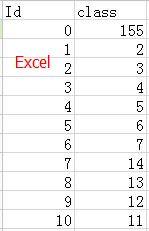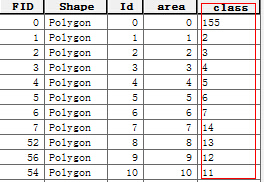添加一个新的字段到shp文件中,并且从Excel里导入数据到该字段。原shp文件里的字段ID应该与Excel里的字段ID一一对应才能正确的导入。下图分别是shp的字段和Excel的字段

将class字段添加到shp中去:
(1)从Excel中读取数据(为了读取方便,存为.csv或者txt文件)
QStringList readFromCSV(QString mfilename) { QStringList readlist; if (mfilename !="") { QFileInfo csvFI(mfilename); QString ext = csvFI.suffix(); if ( ext == "csv" || ext == "txt") { QFile *importFile = new QFile(mfilename); if ( !importFile->open(QIODevice::ReadOnly | QIODevice::Text)) { QMessageBox::information(NULL, "error", "Cannot open import file !", QMessageBox::Yes | QMessageBox::No); return readlist; } readlist.clear(); QTextStream readIn(importFile);//读入文件 while ( !readIn.atEnd()) //读取每一行 { readlist.push_back(readIn.readLine()); } importFile->close(); } } return readlist; }
返回的readlist是所有行的数据,下面要根据Id来将每一行后面的class字段插入shp文件
(2)插入class字段及值到shp
首先要创建新字段名,然后再插入值
bool ImportLandInfo::insertInfo(QString mShpfile) { QgsVectorLayer * newLayer; newLayer = new QgsVectorLayer(mShpfile, fileinfo.baseName(), "ogr"); if ( newLayer != NULL) { qDebug("newLayer is valid"); } else { return false; } QStringList readlist = readFromCSV(“F:\data.csv”);//Excel文件 //创建新字段 QList<QgsField> newFieldList; QStringList fields = readlist.at(0).split(",", QString::SkipEmptyParts); //得到Excel的字段名 for (int i = 0; i < fields.count(); ++i) { QString fieldname; if ( fields.at(i) == "Id" ) { continue; } else { fieldname = fields.at(i); } QgsField shpField( fieldname, QVariant::String); newFieldList.push_back( shpField ); } QgsVectorDataProvider* vectorProvider = newLayer->dataProvider(); vectorProvider->addAttributes( newFieldList ); //新字段中插入值 QMap<int, int> idmap = generateIdIndex(); //由原shp图层得到QMap<ID, featureId> int fieldIndex = -1; //每个待插入字段的索引号 int IdIndex = -1; // ID字段的索引号 for (int j = 0; j < readlist.count(); ++j) { QString filed; QgsChangedAttributesMap changeMap; QgsAttributeMap changeAttributeMap; QStringList field = readlist.at( j ).split(",", QString::SkipEmptyParts); for ( int k = 0; k < field.count(); ++k) { if ( field.at(k) == "Id" ) { IdIndex = k; continue; } if ( j == 0) //第一行时是计算字段在属性表中的index { fieldIndex = vectorProvider->fieldNameIndex( field.at(k) ); break; } else //不是第一行则插入 { changeAttributeMap.insert( fieldIndex + k - 1, QVariant( field.at(k) ) ); } } if ( j == 0) { continue; } int ID = field.at(IdIndex).toInt(); QMap<int, int>::iterator i = idmap.find( ID); //找到指定ID对应的要素id(featureId) int featureId = i.value(); changeMap.insert( featureId, changeAttributeMap ); vectorProvider->changeAttributeValues( changeMap ); } delete vectorProvider; return true; }
generateIdIndex()是为了得到Id对应的FeatureID,因为属性字段Id和要素的FeatureID是不一致的。
QMap<int, int> ImportLandInfo::generateIdIndex() { QMap<int, int> idMap; QgsVectorLayer * orignalLayer; QFileInfo fileinfo(moriginalShpfile); orignalLayer = new QgsVectorLayer(moriginalShpfile, fileinfo.baseName(), "ogr"); if ( orignalLayer != NULL) { qDebug("newLayer is valid"); } QgsVectorDataProvider* vectorProvider = orignalLayer->dataProvider(); QgsFeature feature; int idIndex = vectorProvider->fieldNameIndex( "Id" ); int count = orignalLayer->featureCount(); for ( int i = 0; i < count; ++i) { orignalLayer->featureAtId( i, feature); const QgsAttributeMap &attributes = feature.attributeMap(); int id = -1; id = attributes[ idIndex].toInt(); idMap.insert( id, feature.id()); } return idMap; }
这样字段class的值就添加到shp中去了。结果如图:

参考链接:QGis(四)shp矢量图层添加新字段